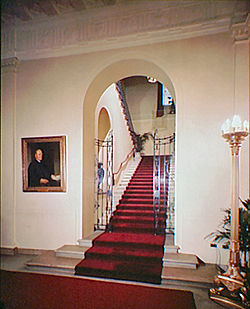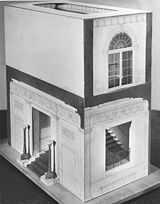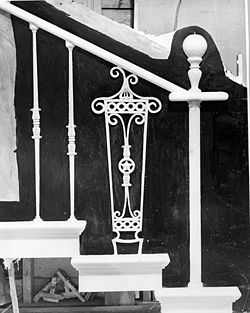
Grand Staircase (White House)
Encyclopedia



White House
The White House is the official residence and principal workplace of the president of the United States. Located at 1600 Pennsylvania Avenue NW in Washington, D.C., the house was designed by Irish-born James Hoban, and built between 1792 and 1800 of white-painted Aquia sandstone in the Neoclassical...
, the official home of the president of the United States
President of the United States
The President of the United States of America is the head of state and head of government of the United States. The president leads the executive branch of the federal government and is the commander-in-chief of the United States Armed Forces....
. The stairway is primarily used for a ceremony called the Presidential Entrance March. The present Grand Staircase, the fourth staircase occupying the same general space, was completed in 1952 as a part of the Truman White House reconstruction. The Grand Staircase is entered on the State Floor from the Entrance Hall
Entrance Hall
The Entrance Hall is the primary and formal entrance to the White House, the official residence of the President of the United States. The room is rectilinear in shape and measures approximately 31 by 44 feet...
.
Hoban and Latrobe’s staircases
Though White House architect James HobanJames Hoban
James Hoban was an Irish architect, best known for designing The White House in Washington, D.C.-Life:James Hoban was born and raised in a thatched cottage on the Earl of Desart's estate in Cuffesgrange, near Callan in Co. Kilkenny...
originally located the main ceremonial staircase at the west end of the Cross Hall, he placed a staircase in the present site of the Grand Staircase in both his initial 1793 plan and 1814 reconstruction designs. No section study exists to illustrate either of Hoban’s staircases. Hoban’s original design of the Grand Staircase at the west end of the Cross Hall was altered by Benjamin Henry Latrobe in 1803 during the administration of Thomas Jefferson
Thomas Jefferson
Thomas Jefferson was the principal author of the United States Declaration of Independence and the Statute of Virginia for Religious Freedom , the third President of the United States and founder of the University of Virginia...
. Hoban envisioned the Imperial stair form with a single central stair rising from the east to a landing on the west wall with double runs returning back to the east on each side. Latrobe's alteration placed a double run on either side rising from the west to a landing on the east and a single run returning west to the second floor.

McKim's new Grand Staircase
In 1902, President Theodore RooseveltTheodore Roosevelt
Theodore "Teddy" Roosevelt was the 26th President of the United States . He is noted for his exuberant personality, range of interests and achievements, and his leadership of the Progressive Movement, as well as his "cowboy" persona and robust masculinity...
engaged architect Charles Follen McKim
Charles Follen McKim
Charles Follen McKim FAIA was an American Beaux-Arts architect of the late 19th century. Along with Stanford White, he provided the architectural expertise as a member of the partnership McKim, Mead, and White....
, of the firm McKim, Mead, and White
McKim, Mead, and White
McKim, Mead & White was a prominent American architectural firm at the turn of the twentieth century and in the history of American architecture. The firm's founding partners were Charles Follen McKim , William Rutherford Mead and Stanford White...
, to reconfigure and redesign the White House. McKim’s plan removed the Grand Staircase at the West End of the Cross Hall to increase the size of the State Dining Room by more than a third. McKim relocated the new Grand Staircase in the eastern end of the Cross Hall, opposite the entrance to the Green Room
Green Room (White House)
The Green Room is one of three state parlors on the first floor in the White House, the home of the president of the United States. It is used for small receptions and teas. During a state dinner, guests are served cocktails in the three state parlors before the president, first lady, and visiting...
in the site of Hoban's less formal east staircase.
McKim's Grand Staircase adopted the Imperial stair form: a central run beginning on the south and rising to a landing on the north, with double runs doubling back to the south as it rises to the second floor. Formal in plan, its relatively narrow opening into the Cross Hall limited visibility of the President, First Lady and their official guests. McKim's Grand Staircase was entered through an arched opening with the first two steps protruding into the Cross Hall. A decorated wrought iron gate on the State Floor was normally kept closed except during state ceremonies. A pair of niches flanked the center run and the first course used a heavy crimson silk cord as a decorative railing. The stair was constructed in Joliet marble and covered in a crimson stair carpet. A lantern similar to one selected by McKim for the Entrance Hall was hung above the landing.
Delano, Winslow and the Truman reconstruction



Calvin Coolidge
John Calvin Coolidge, Jr. was the 30th President of the United States . A Republican lawyer from Vermont, Coolidge worked his way up the ladder of Massachusetts state politics, eventually becoming governor of that state...
administration, took a major physical toll on the structural integrity of the White House. Cracks appearing in walls and ceilings, and a sagging East Room
East Room
The East Room is the largest room in the White House, the home of the president of the United States. It is used for entertaining, press conferences, ceremonies, and occasionally for a large dinner...
ceiling in 1948 signaled that immediate attention was needed. To save the White House President Truman set in place a process of dismantling the interior structure, constructing a load-bearing internal steel structure, and reconstructing the interior rooms within the new framework.
The chief architect of the Truman White House reconstruction was William Adams Delano
William Adams Delano
William Adams Delano , an American architect, was a partner with Chester Holmes Aldrich in the firm of Delano & Aldrich. The firm worked in the Beaux-Arts tradition for elite clients in New York City, Long Island and elsewhere, building townhouses, country houses, clubs, banks and buildings for...
with a temporary Office of the White House Architect headed by Lorenzo Simmons Winslow. Truman viewed the White House reconstruction as an opportunity to address the redesign of the Great Staircase. By January 1949 Winslow had produced a design that Truman was near to approving. It closed the Cross Hall opening and reoriented the opening of the new Grand Staircase to the east wall of the Entrance Hall. In the favored design Winslow deleted the paired Roman Doric column screen.
Truman sought approval of Winslow's design from the more senior Delano. Delano was dismayed by the plans and elevations and feared that dismantling the columns and the Cross Hall opening created by McKim was a serious mistake. Delano was so concerned about the design he travelled to Washington to meet with Truman and Winslow in person to work out a solution. Winslow prepared a series of detailed architectural models called maquette
Maquette
A maquette is a small scale model or rough draft of an unfinished architectural work or a sculpture...
s to explore the design of the Grand Staircase and how it related to the Entrance Hall and Cross Hall. The paired Doric columns were retained, and an opening in the Cross Hall looking into the Grand Staircase were unanimously agreed upon.
Construction of the staircase proceeded using several cream and taupe colored marbles including Vermont Westland cream. The new Grand Staircase was framed by a rectilinear archway, with the interior side walls faced with the seals of the original 13 states. Above the opening facing the Cross Hall was a plaster arch with a spread American eagle in bas relief with a corona of 13 radiating arrows. A contrasting marble string course with triglyphs and five pointed stars projected around the stair well at the landing. Winslow designed a custom railing with cast iron balusters that incorporated the five pointed federal star within a circle he used in the carved moulding.
Decoration
A stair carpet in a shade of red has been used since the administration of Theodore RooseveltTheodore Roosevelt
Theodore "Teddy" Roosevelt was the 26th President of the United States . He is noted for his exuberant personality, range of interests and achievements, and his leadership of the Progressive Movement, as well as his "cowboy" persona and robust masculinity...
. During the Kennedy restoration, the carpet was made deeper, more crimson. A mahogany pier table with gilded caryatid
Caryatid
A caryatid is a sculpted female figure serving as an architectural support taking the place of a column or a pillar supporting an entablature on her head. The Greek term karyatides literally means "maidens of Karyai", an ancient town of Peloponnese...
supports attributed to New York cabinetmaker Charles-Honoré Lannuier
Charles-Honoré Lannuier
Charles-Honoré Lannuier, French-born American cabinetmaker , lived and worked in New York City. In Lannuier's time, the style of his furniture was described as "French Antique." Today his work is classified primarily as Federal furniture, Neoclassical, or American Empire.-Early life and...
is located at the bottom of the stair. Portraits of 20th century presidents and first ladies hang on the walls. An English cut crystal chandelier of the mid-19th century hangs over the first landing. In 1998 Hillary Clinton working with then Curator of the White House Betty Monkman refurbished the Grand Staircase. A new carpet for the Grand Staircase and the Cross Hall was designed incorporating a border of laurel leaves and five pointed stars within a circle, a motif found in Winslow's carved marble Truman era string course entablature and in the balusters of the Grand Staircase. A more vivid red was selected, and several shaded of yellow gold. New swag and jabot drapery in the same red and yellow-gold colors were made for the staircase and Entrance Hall.
Further reading
- Abbott, James A. A Frenchman in Camelot: The Decoration of the Kennedy White House by Stéphane Boudin. Boscobel Restoration Inc.: 1995. ISBN 0-9646659-0-5.
- Clinton, Hillary Rodham. An Invitation to the White House: At Home with History. Simon & Schuster: 2000. ISBN 0-684-85799-5.
- McKellar, Kenneth, Douglas W. Orr, Edward Martin, et al. Report of the Commission on the Renovation of the Executive Mansion. Commission on the Renovation of the Executive Mansion, Government Printing Office: 1952.
- Monkman, Betty C. The White House: The Historic Furnishing & First Families. Abbeville Press: 2000. ISBN 0-7892-0624-2.
- Seale, William. The President's House. White House Historical Association and the National Geographic Society: 1986. ISBN 0-912308-28-1.
- Seale, William, The White House: The History of an American Idea. White House Historical Association: 1992, 2001. ISBN 0-912308-85-0.
- The White House: An Historic Guide. White House Historical Association and the National Geographic Society: 2001. ISBN 0-912308-79-6.
External links
- White House website for the Entrance and Cross Hall
- White House Museum's Entrance Hall page, with many additional historical pictures
- White House Museum's Historical Plans of the 1st Floor

